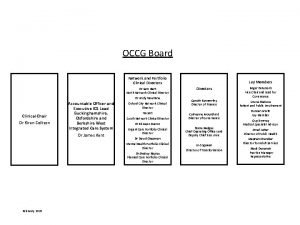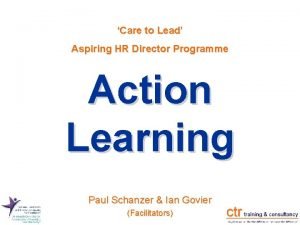2017 PAEA Workshops Program Directors 101 Where Does































- Slides: 31

2017 PAEA Workshops Program Directors 101 Where Does Interprofessional Education (IPE) Fit Into Your Program Curriculum? Sandra Banas Ruth Ballweg

Objectives • Define interprofessional education • Describe the concept interprofessional team based care • Describe the interprofessional practice competency domains • Design strategies to implement interprofessional curriculum

What Is Interprofessional Education (IPE) ? When students from 2 or more professions learn about, from and with each other to enable effective collaboration and improve health outcomes. WHO, Framework for IPE, 2011

Why IPE? Medical errors result from poor communication and gaps in delivery of care • Institute of Medicine, To Err is Human (1999)

Why IPE? The Triple Aim • Safety • Efficiency • Patient Satisfaction Institute of Medicine, Crossing the Quality Chasm: A New Health System for the 21 st Century (2001)

Paradigm Shift Physician centered practice to Patient centered practice Practitioner autonomy to Team collaboration Focus on illness & cure to Focus on health promotion Passive patient role to Involved patient & families Acute, episodic care to Care for chronic conditions Aschenbrener CA, Clearing a Path Ahead for IPE Presentation: Collaborating Across Borders II, Halifax, 2007 Institute of Medicine, Crossing the Quality Chasm

Goal of Interprofessional Education • Prepare all health professions students for deliberatively working together with the common goal of building a safer and better patient-centered and community-population oriented U. S. health care system.

Interprofessional Team-Based Care • Care delivered by intentionally created, usually relatively small work groups in health care, who are recognized by others as well as by themselves as having a collective identity and shared responsibility for a patient or group of patients. • • Rapid response teams Palliative care teams Primary care teams Operating room team Interprofessional Education Collaborative Expert Panel. Core competencies for Interprofessional collaborative practice: Report of an expert panel. May 2011. Washington, DC. Interporfessional Education Collaborative.

Teamwork • No elite sports team or marching band is successful without teamwork.

Education Practice Collaborativ e Practice PATIENT Collaborative Education

How will IPE benefit students as future clinicians? • Understanding of others • Fosters communication • Personal growth/humility • Decreased med errors • Increased career satisfaction • Understanding place in health care system • Improved patient care

U. S. Health Professions Accreditation Organizations

Standards for the Curriculum • B 1. 08 The curriculum must include instruction to prepare students to work collaboratively in interprofessional patient centered teams. • ANNOTATION: Such instruction includes content on the roles and responsibilities of various health care professionals, emphasizing the team approach to patient centered care beyond the traditional physician-PA team approach. It assists students in learning the principles of interprofessional practice and includes opportunities for students to apply these principles in interprofessional teams within the curriculum.

Interprofessional Education Collaborative – Expert Panel IPEC Report, May 2011 • Report provides core competencies for interprofessional education • Includes: • American Association of Colleges of Pharmacy (AACP) • American Association of Colleges of Nursing (AACN) • Association of American Medical Colleges (AAMC) • American Dental Education Association (ADEA) • American Association of Colleges of Osteopathic Medicine (AACOM) • Association of Schools of Public Health (ASPH) Interprofessional Education Collaborative Expert Panel. Core competencies for interprofessional collaborative practice: Report of an expert panel. May 2011. Washington, D. C. Interprofessional Education Collaborative. IPEC Competencies

Interprofessional Collaborative Practice Competency Domains Competency Domain 1 • Values/Ethics for Interprofessional Practice • Work with individuals of other professions to maintain a climate of mutual respect and shared values • Roles/Responsibilities Competency Domain 2 • Use the knowledge of one’s own role and those of other professions to appropriately assess and address the healthcare needs of the patients and to promote and advance the health of populations • Interprofessional Communication Competency Domain 3 • Communicate with patients, families, communities, and professionals in health and other fields in a responsive and responsible manner that supports a team approach to the promotion and maintenance of health and the prevention and treatment of disease. • Teams and Teamwork Competency Domain 4 • Apply relationship building values and the principles of team dynamics to perform effectively in different team roles to plan, deliver and evaluate patient-/population centered care and population health programs and policies that are safe, timely, efficient, effective, and equitable

Interprofessional Planning: Where the Rubber Meets the Road !!

IPE Planning Committee Members • Profession Representation • University or College Programs • Program Representation • Advocate • Pragmatic • Realist • Student Representation • Very Important !

Who is On Your IPE Planning Committee?

IPE - Good News and Bad News • Good News • Models best practice • Patient centered care • Emphasis on: • Communication • Teamwork • Patient safety • Bad News • Talking the talk but not walking the walk • Faculty buy in • Faculty development • MUST have dedicated time • Planning • Implementation • Planning • IPE warriors can overshadow other members

IPE Implementation

Implementing IPE Experiences • Involve planning committee, including students ! • Walk the talk ! • Incorporate innovative practice models into the curriculum and link these models to IPEC competencies • Start small • Schedule dedicated time for IPE experiences • Set aside time for reflection

IPE Evaluation • Involve planning committee, including students ! • Develop assessment tools based on team objectives • Integrated evaluation plan

IPE Best Practices • Begin early • Identify topics that cross all professions • • • Ethics Social determinants of health Opioid epidemic Palliative care Quality & safety • Implement experiences throughout program • Didactic • Clinical • Reflection & feedback

How Do PA Programs Do This?

Interprofessional Education at Nova Southeastern University • First Semester • Intro to PA Profession course – Focus on healthcare team. • Lecture and Activity to interview other health professions • Second & Third Semester • IPE Day – Scheduled day for DO, PT, OT, PA, Pharmacy and Nursing students • Lectures, Activities, Simulation exercises • Fourth Semester • Students required to spend half day observing interprofessional team of PA, Social Worker and law enforcement managing care of homeless through Project H. O. P. E.

Interprofessional Education at Shenandoah University • Co-curricular activities • Brown-Bag lunches • Simulation Exercises • Clarion Competition • Primary Care Progress • Interprofessional Service Learning Project • Interprofessional Student Run Clinics

Interprofessional Education at Upstate Medical University • White Coat Ceremony (CHP) • Case-Based Activity (PA, MD, NP, PT) • Virtual Medical Error Room • Service activities • Community Engagement Session

Summary • Interprofessional Collaboration improves patient outcomes • Interprofessional Collaboration is expected and is reflected by US Healthcare Reform policies • Interprofessional Education is necessary to prepare the healthcare workforce to work collaboratively • Interprofessional Education takes time; time is essential for planning and implementation • Barriers and challenges are inevitable – be prepared and be flexible !

Questions?

Acknowledgements • Many thanks to: – Rachel Carlson, Melissa Coffman & Joan Ward who contributed content to this presentation

References • Institute of Medicine. Educating for the Health Team. October 3, 1972. Available at: http: //www. ipe. umn. edu/prod/groups/ahc/@pub/@ahc/@cipe/documents/asset/ahc_ asset 350123. pdf. Accessed June 2, 1013. • Barr H, Ross, F. Mainstreaming Interprofessional Education in the United Kingdom: A position paper. Journal of Interprofessional Care, 2006, Vol. 20, No. 2 , Pages 96 -104. • Institute of Medicine. Health Professions Education: A Bridge to Quality. April 18, 2003. Available at: http: //www. iom. edu/Reports/2003/Health-Professions-Education-A-Bridge-to. Quality. aspx. Accessed June 2, 2013. • Interprofessional Education Collaborative Expert Panel. Core competencies for interprofessional collaborative practice: Report of an expert panel. May 2011. Washington, D. C. Interprofessional Education Collaborative Available at: http: //www. aacn. nche. edu/educationresources/ipecreport. pdf. Accessed June 2, 2013.
 The national science foundation
The national science foundation Read 180 training
Read 180 training Psea retirement calculator
Psea retirement calculator Mbti activities for small groups
Mbti activities for small groups Cramped workshops set up in shabby tenement buildings
Cramped workshops set up in shabby tenement buildings Glutenstapeling
Glutenstapeling Workshops for rectors
Workshops for rectors Oracle licensing workshops
Oracle licensing workshops Social thinking social learning tree
Social thinking social learning tree Nature explore workshops
Nature explore workshops Google analytics workshops toronto
Google analytics workshops toronto Canadian bioinformatics workshops
Canadian bioinformatics workshops Bioinformatics.ca
Bioinformatics.ca Canadian bioinformatics workshops
Canadian bioinformatics workshops Canadian bioinformatics workshops
Canadian bioinformatics workshops Benzene discovery
Benzene discovery Cyber security posture presentation
Cyber security posture presentation Namata board of directors
Namata board of directors Director brief
Director brief Joint medical holdings
Joint medical holdings Directors emma wolverson
Directors emma wolverson Compliance presentation to board
Compliance presentation to board Board advisory services
Board advisory services Astdd
Astdd German expressionist directors
German expressionist directors Clinical directors network
Clinical directors network National association of deans and directors
National association of deans and directors Daniel piette lvmh
Daniel piette lvmh Aspiring directors programme
Aspiring directors programme Board of directors risk oversight responsibilities
Board of directors risk oversight responsibilities Thai institute of directors association
Thai institute of directors association Npc board
Npc board























































